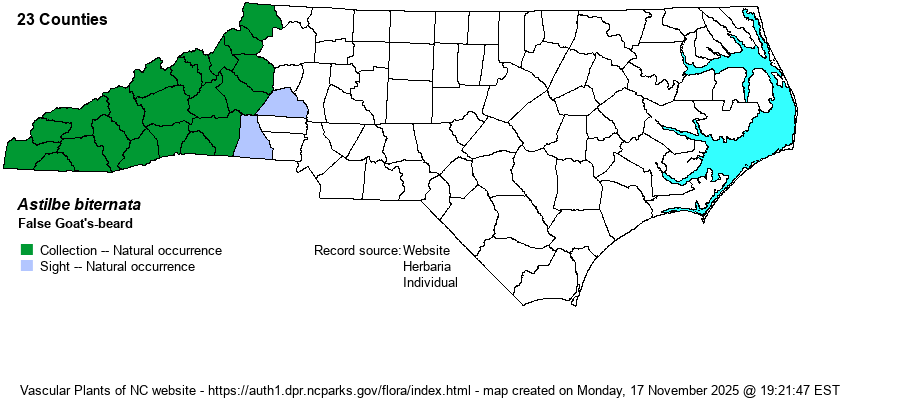| Section 6 » Order Rosales » Family Saxifragaceae |
Show/Hide Synonym
| taxonName | relationship | relatedTaxonName | relatedTaxonRefText | relComments |
|---|
|
|
|
|
|
|
|
|
|
| Astilbe biternata | < | Astilbe biternata | Flora of North America (1993b, 1997, 2000, 2002a, 2002b, 2003a, 2004b, 2005, 2006a, 2006b, 2006c, 2007a, 2009, 2010) | | | Astilbe biternata | < | Astilbe biternata | Radford, Ahles, and Bell (1968) | | | Source: Weakley's Flora |
|
| Author | (Ventenat) Britton | |
| Distribution | Throughout the Mountains; does range in the southwestern Piedmont into the South Mountains and adjacent Catawba County (apparently at Bakers Mountain).
This is a Southern Appalachian endemic, ranging north just to southwestern VA, adjacent WV, and eastern KY, and south to northern GA. | |
| Abundance | Fairly common to common in the Mountains, with specimens for all such counties other than Alleghany. Uncommon in the higher ranges of the southwestern Piedmont. | |
| Habitat | This is a species of Rich Cove Forests, somewhat more frequent near seepages in the forests, but water is not a requisite. It can occur at higher elevations in cool, rich forests such as Boulderfield Forests. |
| Phenology | Blooms in May and June, and fruits in July and August. | |
| Identification | This is a tall herbaceaus species, growing to about 4-5 feet tall. It has very large basal and stem leaves, which are alternate; these are 2-3 times ternately divided, and thus there are numerous leaflets per leaf. Each leaflet is fairly large, at about 3 inches long and half as wide, and all are strongly serrated. Aruncus dioicus is vary similar, but the terminal leaflets on each leaf is they key. In Astilbe, the terminal leaflet is usually 3-lobed, somewhat like a Red Maple (Acer rubrum) leaf, whereas all leaflets in Aruncus are usually unlobed. Some other leaflets in Astilbe might be 2- or 3-lobed, but it has more jagged/divided leaflets on average than in Aruncus. Each has a very similar inflorescence, normally solitary at the end of the main branch; it is a broad and showy panicle of hundreds of very small white flowers, held above the upper leaves. Aruncus is very similar, but that species has 3-4 pistils/carpels per flower, whereas Astilbe has two per flower. There are other differences in flower structure between these two, but the keys in identification are the number of pistils/carpels per flower and the terminal leaflet shape. In addition, Aruncus leaves can at times look a bit bronzed-green (brownish tint), as opposed to a brighter green in Astilbe. Each occurs in the same habitats, though Astilbe is in the "saxifrage family" and Aruncus is in the "rose family". Each of these can be seen in the same places, blooming around the same time of year, in many of the mountains rich slopes near seepages. This is an excellent example of convergent evolution. | |
| Taxonomic Comments | None
| |
| Other Common Name(s) | Appalachian False Goat's-beard, Appalachian Astilbe | |
| State Rank | S3 [S4] | |
| Global Rank | G4G5 | |
| State Status | | |
| US Status | | |
| USACE-agcp | | |
| USACE-emp | FACU link |

